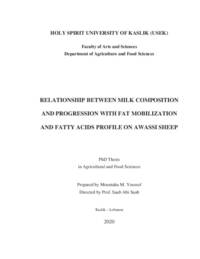Relationship Between Milk Composition And Progression With Fat Mobilization And Fatty Acids Profile On Awassi Sheep

Authors:
This study aimed at assessing fatty acid composition of milk and fat tail of lactating Awassi ewes during lactation. Animals were maintained under traditional system with feed supplementation and were kept in different farms at Bekaa: Terbol station (33°48'40.7"N, 35°59'24.3"E), Anjar (33°44'34.3"N, 35°56'57.4"E) and Mrayjat (33°48'28.5"N, 35°49'04.4"E).Twenty-four multiparous ewes were selected, 8 ewes on each farm, aged between 3 to 6 years with an average body weight of 56.88 ± 2.02 kg. Monitoring was carried out throughout lactation period from the day of lambing on the following basis: D0, D10, D30, D70, D100 and D130. Body weight, body condition score (BCS) and fat tail circumference (FTC) were measured. Milk samples and biopsies of caudal adipose tissue were performed for further analysis of fatty acids. Milk main components (%): lipids, proteins, lactose, solids non-fat (SnF) and total solids (TS), as well as their physicochemical properties: total acidity (°SH), density and freezing point depression (FPD, °C) were analyzed by Milkoscan FT120 instrument. In addition, fat content (%) of fat tail was calculated. Milk main components were considerably influenced by the progression of lactation on the different farms (P < 0.05). As well as fatty acids showed significant differences with the progress of lactation (P < 0.05). The highest shares of fatty acids in milk were for C16:0, C18:1c9, C18:0, C14:0 and C10:0. Short chain fatty acids (SCFA) of milk was increasing until the end of the lactation period. However, MCFAs showed an overall increase above
34% from the start of lactation until the end of the experimental period. Regarding unsaturated fatty acids, monounsaturated fatty acids (MUFA) and polyunsaturated fatty acids (PUFA) in milk showed a decrease with the progression of lactation. The main fatty acids in fat tail adipose tissue were C14:0, C16:0, C18:0 and C18:1n9c. Thrombogenicity and x atherogenicity index of Awassi ewes’ milk in all farms showed notable increments toward the end of lactation, whereas hypocholesterolemia ratio showed decline from the beginning till the end of lactation. Results obtained showed the expected correlation between fatty acids
of fat tail and milk, in particular PUFA. Thus, the increase in healthy milk fatty acids from grazing ewes will provide healthier dairy products for later human consumption especially from earlier periods in lactation.
